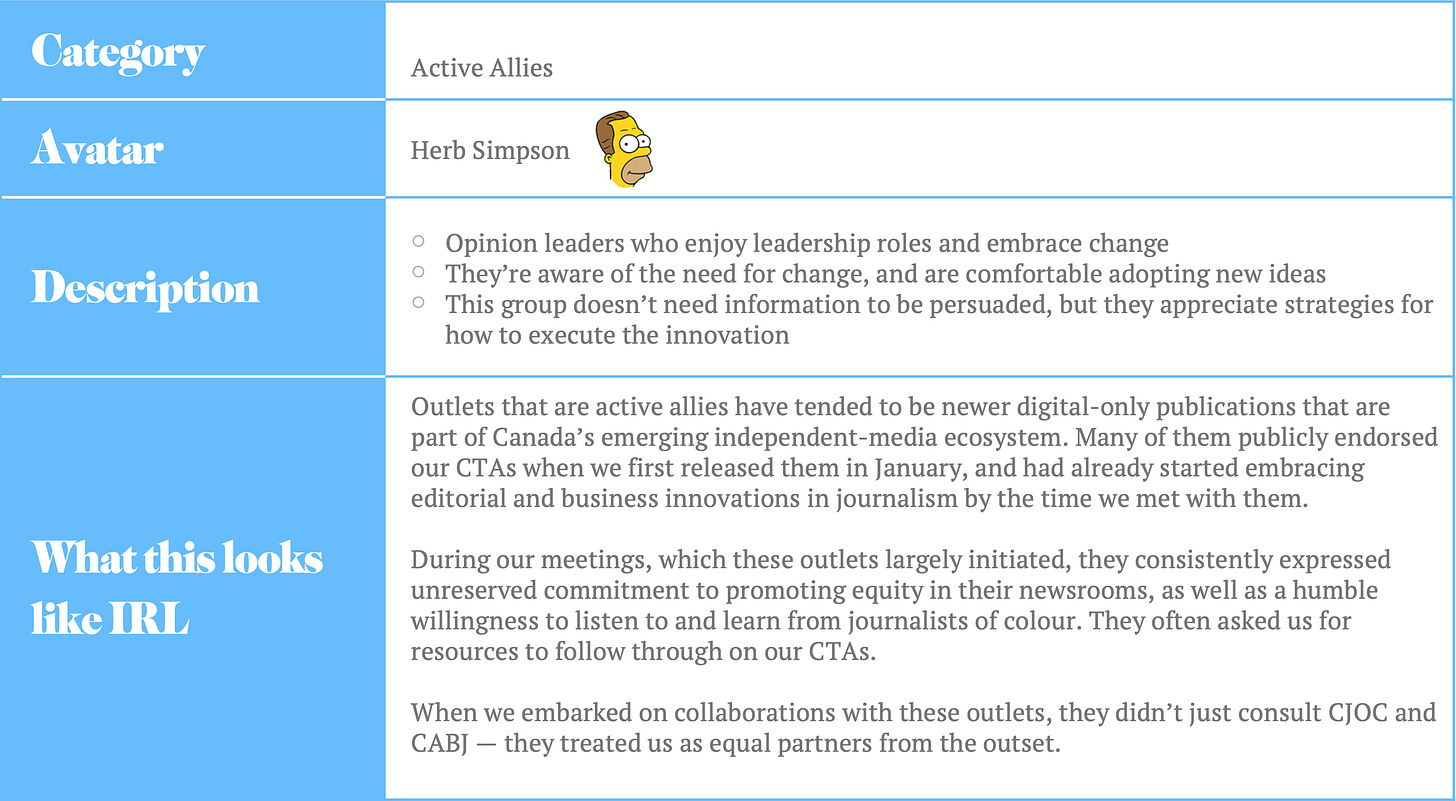Canadian journalism outlets as Simpsons characters: A visual guide
They’re helpful avatars for the media outlets that CJOC and CABJ have been meeting to discuss our Calls to Action to strengthen newsroom diversity.
Hey y’all! Anita here. I want to give a quick shout-out to my new subscribers — welcome to The Other Wave and thanks so much for reading 📰
My insider’s approach
This month, I've been watching a lot of Treehouse of Horror, otherwise known as The Simpsons’ annual Halloween specials. Aside from being a gut-bustingly funny distraction during a particularly concerning time, the long-running show’s nuanced characters serve as helpful avatars for the roughly 20 media outlets that Canadian Journalists of Colour (CJOC) and the Canadian Association of Black Journalists (CABJ) have been meeting over the past four months to discuss our Calls to Action (CTAs) to strengthen newsroom diversity across Canada.
Remember my last newsletter in which I described the Diffusion of Innovation theory and Spectrum of Allies framework, and how they informed my approach to advocating for equity in Canadian journalism? Well, here’s a Simpsons-inspired breakdown of the kinds of outlets that fall under these different categories, and what to look for when trying to identify earnest allies committed to doing the work:

Simpsons characters as avatars for Canadian media outlets. (📸: Twentieth Century Fox Film Corporation)
Ed. note: The descriptions for each category come from Boston University.





Remember that everyone is capable of learning, so embrace a growth mindset and just do the work. CJOC and CABJ are both committed to supporting all Canadian journalism outlets on their respective journeys toward creating more equitable and inclusive newsrooms. You don’t have to be a Burns or a Bouvier.
My outsider’s approach
Thanks to everyone who gave me suggestions for Toronto-based designers focused on social impact. After interviewing a handful of talented people over the past few months, I’ve chosen a value-aligned design studio staffed by a mission-focused and innovative team that I’m incredibly excited to collaborate with! Once we get started, I’ll introduce these folks to you in an upcoming newsletter.
In addition to conducting these interviews, I’ve been working on a business model canvas for my new, yet-to-be-announced publication with the support of my mentor, Petra Kassun-Mutch, a visionary serial entrepreneur and innovator who’s deeply committed to creating a more inclusive, just, human-centred and generative economy. Petra initially presented me with three options for business model canvases:
Alexander Osterwalder’s business model canvas: This canvas centres the business above all else; it focuses on developing a great product, and then expanding its reach as much as possible to reach financial sustainability.
Lean4Flourishing’s sustainable business model canvas: This canvas’ framework for a successful enterprise is one that creates social benefits and environmental regeneration in addition to financial returns.
C.V. Harquail’s feminist business model canvas: This canvas’ framework applies feminist business principles about gender equity, social justice, community and profit-making to amplify an enterprise’s impact, as well as generate financial returns.
All three canvases have valid frameworks, depending on your business’ goals, but the latter two resonated most with me because of my publication’s focus on social impact. I ultimately decided to work with Harquail’s business model canvas because it encompasses many of the values that are essential for the development of a more inclusive democracy. Tell me: What do you think of these three business model canvases? Which one would you use?
In my community
“Local news sustainability: API advisers highlight three paths forward,” the American Press Institute project for which I was a consultant, and that I referenced in my last newsletter; this series profiles three local media outlets that are characteristic of outlets across America and the types of challenges they’re experiencing
“How the government can help save local news without endangering its editorial independence,” an op-ed in Poynter about the efforts of the Rebuild Local News coalition, a broad range of stakeholders with an ambitious plan to dramatically increase the number of local reporters without creating a big new government agency
Cool stuff I like
Scarborough at the Toronto Reel Asian International Film Festival on Nov. 19, an upcoming live script read and artist talk with the talented folks behind the film based on the book by local author Catherine Hernandez
“The Importance of Being Earnest: A Guide for Today's Cynical World,” a 2012 Atlantic essay that’s worth revisiting because it encourages folks to “do a better job at being earnest, honest, authentically joyful, less guarded” — qualities we all need more of in 2020
“Treehouse of Horror VI,” or the best Simpsons Halloween special of all time — come @ me
How you can support The Other Wave
My professional mission has always been to support the global movement towards more thoughtful, impactful news coverage, and all the ways that manifests. If The Other Wave gets you to think even a little differently about journalism, especially in Canada, then I will have accomplished what I set out to do. And if TOW gets you to take action and support Canadian media outlets — especially ones that strive to be innovative and inclusive — I will have exceeded my expectations.
If my values and goals resonate with you, I’d really appreciate any contribution you can make to The Other Wave, whether it's providing feedback, passing along resources, donating money or simply sharing this newsletter with your friends.
See ya in two weeks,
Anita



